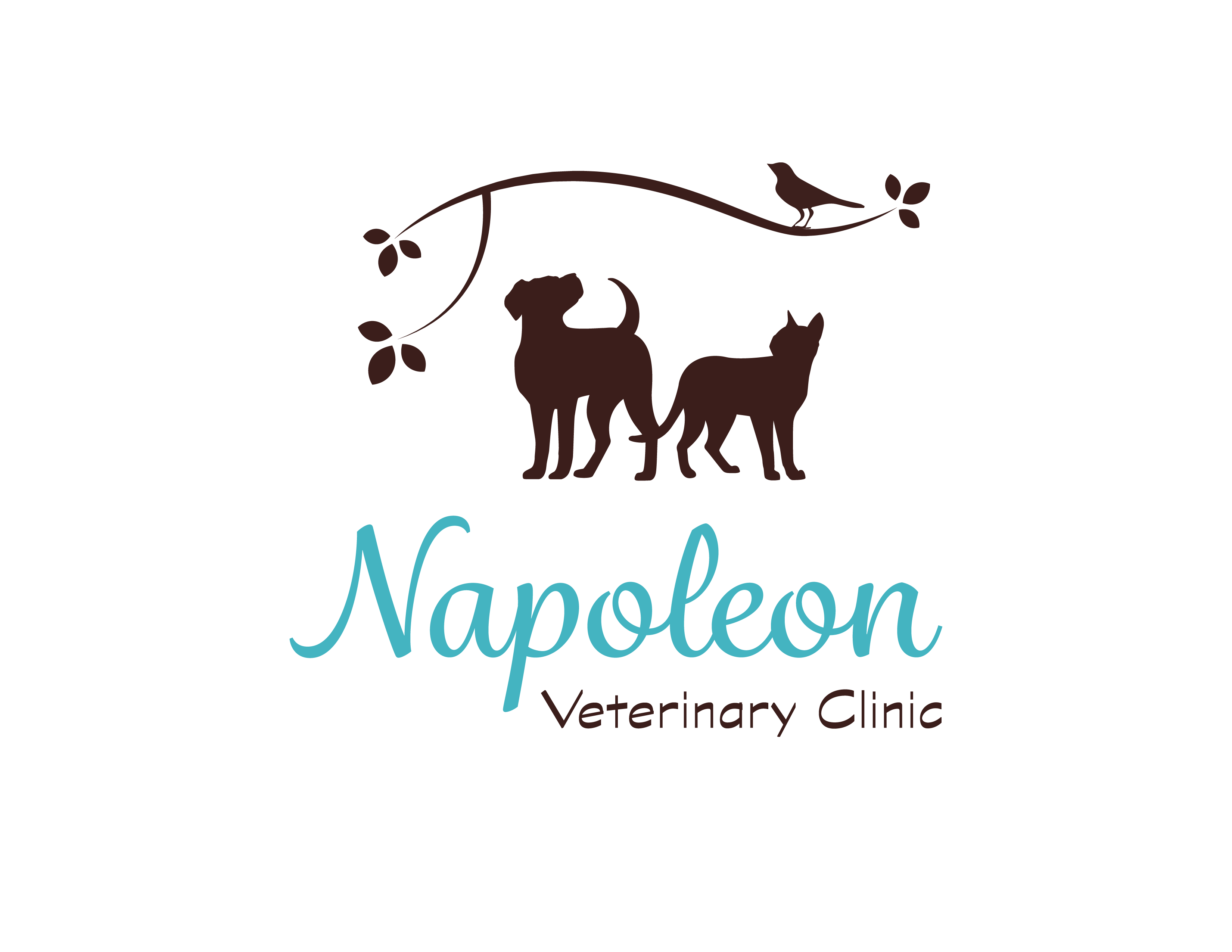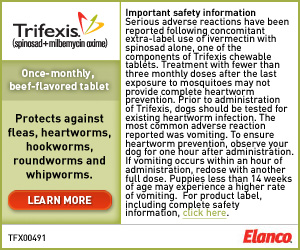
Dental Care
Just like in humans, dental care is an important part of your pet’s overall health. Dental disease is the most commonly diagnosed disease in dogs and cats. Statistics show that 8 of 10 animals over the age of three are affected with dental problems.
How to Brush Your Pet’s Teeth
Here’s a step-by-step guide to keeping those chompers sparkling white at home.
- Start brushing your pet’s teeth early — 8 to 12 weeks old is best. If you brush every day, your pet will
become familiar with the routine when their permanent teeth erupt. Please note: You may need to stop brushing while your pet loses her baby teeth. Her mouth will be a bit sore and handling may cause more pain. Continue once all permanent teeth come in. - Work with your pet’s mouth. Be patient and make it fun. Use love and praise, and try to practice at the same time each day to establish a routine. Choose a quiet time, such as late in the evening. Or, if your pet is highly motivated by food, try just before dinner so she’ll be rewarded for her cooperation.
- Handle your pet’s muzzle and touch her lips. Work up to rubbing the teeth and gums with your finger. Put a few drops of water flavored with low-sodium chicken or beef bouillon for dogs and tuna juice for cats in your pet’s mouth and she’ll begin to look forward to these sessions.
- Rub the teeth gently with a bouillon- or tuna- flavored washcloth or a piece of gauze wrapped around the end of your finger.
- Finally, use a finger brush or a soft veterinary or human toothbrush to brush the teeth using the bouillon water or tuna juice. Hold the brush at a 45- degree angle to the tooth and brush gently back and forth or in a circular pattern from gum to tip. Brushing the tongue side of the teeth is less critical, but still good. Offer rewards and treats when your pet allows you to brush.
- Consider other dental aids. A large selection of veterinary toothpastes, oral rinses, and gels are available to you. Our veterinary team can help you select the right one for you and your pet. These products all enhance your home care program, but daily brushing is best. Avoid human toothpaste because fluoride and detergents can be harmful if swallowed. Hydrogen peroxide can be harsh on the gums and shouldn’t be swallowed either. Baking soda has a high sodium content and should be avoided in older pets.
- Pick kibble and rubber chew toys that will help keep the teeth clean. Avoid natural bones, which are hard enough to fracture teeth. Our veterinary team can recommend a complete and balanced professional diet to use at feeding time and as a treat.
Bad breath (halitosis) in pets
Does your pet’s mouth smell not so sweet? A bad odor can be a sign of serious problems for your pet, such as periodontal disease or oral or systemic infection.
So discuss your pet’s problem with your veterinarian.
Common mouth myths: true or false?
- Pets are supposed to have bad breath: False.
An odor is not normal. Just like in people, bad breath in pets is often a sign of dental disease and requires treatment to safeguard your pet’s health. - Pets don’t need regular oral hygiene: False.
Even with regular dental cleanings at your veterinary practice, your pet still needs regular tooth brushing to keep his breath sweet and his pearly whites sparkling. - Pets’ mouths clean themselves: False.
While there are some natural enzyme systems at work in your pet’s mouth, it will not keep your pet’s mouth clean. Debris builds up on your pet’s teeth and requires brushing or rubbing to keep the mouth fresh. - Cats don’t need dental care: False.
Cats and small-breed dogs often require more dental care then larger-breed dogs. - Cats have stinky breath because they eat smelly foods: False.
An odor in your cat’s mouth is a sign of a health problem, and you should discuss your pet’s problem with your veterinarian.
Prevention: The best medicine
You can prevent bad breath and dental disease with regular oral care. Our veterinarians recommends daily tooth
brushing. This is the best way to keep your pet’s mouth healthy. You may also use daily oral hygiene rinses, dental diets, water additives, and safe chew toys to keep your pet’s mouth clean. Remember, the more home care that you offer to prevent dental disease, the less care your veterinarian will need to provide to treat problems in the future.
Signs your pet is suffering from dental disease
- Bad breath
- Red gums (healthy gums are a pink, shrimp-like color)
- Pus oozing from gums
- Facial swelling
- Yellow or brownish buildup on the teeth
- Pain: Another clue that your pet may be in pain is if it goes to the food bowl and backs away as if scared or drops food from its mouth.
Treatment: What your veterinarian will do
Your veterinarian will conduct a thorough head-to-toe exam as well as a comprehensive oral exam. If the doctor identifies signs of dental disease, he or she may recommend pre-anesthetic testing. This may include blood work and an electrocardiogram to see whether your pet is a candidate for anesthesia. It is necessary for your pet to be anesthetized for your veterinarian to fully diagnose the source of the problem and take steps to correct it. Remember, untreated dental problems in pets have been linked to serious medical problems, including heart, liver, and kidney disease. So if you notice bad breath or other signs of dental disease, schedule an appointment with your veterinarian.
Form courtesy of Dr. Scott Linick, FAVD, Plainfield Animal Hospital,
South Plainfield, N.J.
Dental X-Rays
Dental radiographs are one of the most important diagnostic tools available to a veterinarian. They allow the internal anatomy of the teeth, the roots and the bone that surrounds the roots to be examined.
Intra-oral radiographs are made using small radiographic films or digital sensors placed inside the patient’s mouth, and provide superior quality for examination of individual teeth or sections of the jaws compared with standard-sized veterinary radiographs. Because veterinary patients will not cooperate when a radiograph or sensor is placed in the mouth, taking dental radiographs requires that the patient is anesthetized or sedated.
Your veterinarian will make a recommendation whether or not to take radiographs of all the teeth (“full-mouth radiographs”), based on the reason for presentation of the patient and the results of initial visual examination of the mouth. It is common for a patient referred for one specific problem to have additional oral problems – these may only become apparent if full-mouth radiographs are made. Full-mouth radiographs also establish a base-line for future comparison.
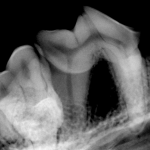 The dog dental xray (left) shows severe bone and root decay, causing pain.
The dog dental xray (left) shows severe bone and root decay, causing pain.
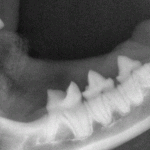 This dog xray (left) is a normal tooth with healthy bone around the root to the gumline.
This dog xray (left) is a normal tooth with healthy bone around the root to the gumline.
Periodontal Disease
Dental Disease In Dogs & Cats
Dental disease is the most commonly diagnosed disease in dogs and cats. Statistics show that 8 of 10 animals over the age of three are affected with dental problems. Dogs and cats don’t really get cavities like humans; they get a build-up of tartar that over time causing an infection of the area around the tooth, and leads to gingivitis and periodontal disease. This infection can then get into the bloodstream causing major problems in many of the organ systems of your pet.
Source & Causes of Dental Disease
Tartar is formed by a build-up of bacteria on the tooth surface. Since dogs and cats do not brush their teeth every day, the bacteria multiply and eventually form a hard substance that is known as plaque, and this leads to tartar formation. This tartar begins to infect the gums and they recede. As the gums recede, unprotected areas of the tooth are exposed and infection sets in causing pain. Although dental disease is not necessarily a heredity issue, some breeds are more susceptible than others.
Signs & Symptoms of Dental Disease
- Foul breath
- Change in eating habits
- Painful mouth – may growl or snarl if mouth or head is touched
- Excessive drooling
- Not wanting to chew on toys
- Dropping food out of mouth when eating
- Rubbing face on ground or pawing at face
- Weight loss
If there’s any evidence of periodontal disease, make an appointment for a dental examination and teeth cleaning. After a proper teeth cleaning, home care is very important. We’ll give you plenty of information to start your pet on a home dental care program.
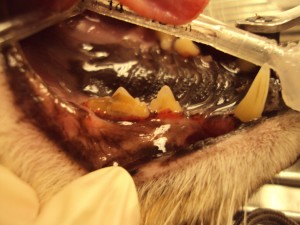
Cat’s mouth before teeth cleaning
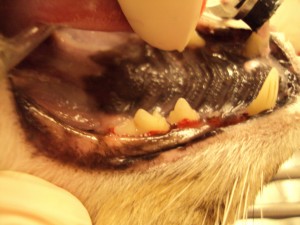
Cat’s mouth after teeth cleaning
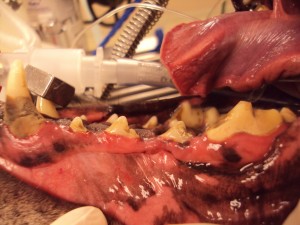
Dog’s mouth before teeth cleaning
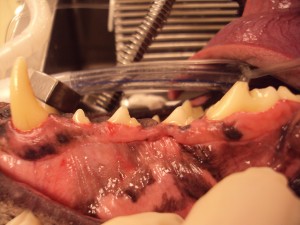
Dog’s mouth after teeth cleaning
Preventative Dental Care
C.E.T. AQUADENT® Drinking Water Additive
Drinking water additive developed by veterinary dental specialists to help maintain dog and cat dental health.
For use as a daily drinking water additive for dogs and cats to help fight plaque and freshen breath.
- Helps maintain oral hygiene, prevent plaque accumulation, and freshen breath when used along with a regular home dental care program for cats and dogs.
- In studies involving 28 mixed-breed dogs, all cases showed significant reduction in dental bleeding and halitosis and marked improvement in gingival health.1
- Study showed approximately 50% reduction in plaque and calculus accumulation in cats drinking water treated with xylitol, an active ingredient in C.E.T. AQUADENT® Drinking Water Additive.2
- Easy to use—pet owners simply add 2 teaspoons to a quart of pet’s drinking water every day to provide clinically tested dental care every time a pet drinks.
- Available in 500 mL bottles and pre-measured, easy-dose 10 mL packets.
Perio-Support For Dogs And Cats
Perio-Support is a daily support formula for dental health and hygiene. formulated specifically to be used between veterinarian dental cleanings to maintain clean teeth and fresh breath. This product is recommended to control plaque formation and support gum health.
Directions For Use: Give 1 teaspoon per meal.
Refrigerate after opening for optimal viability of direct fed microbials.
